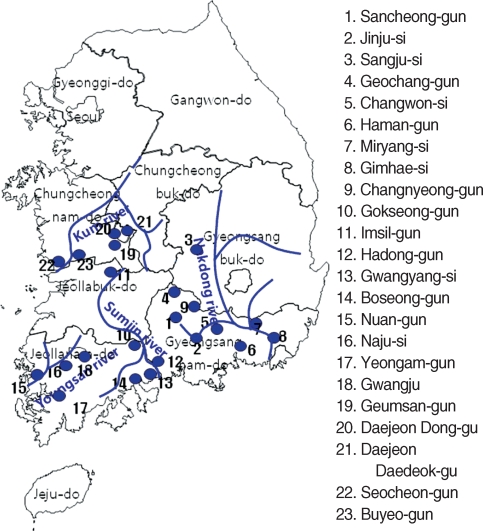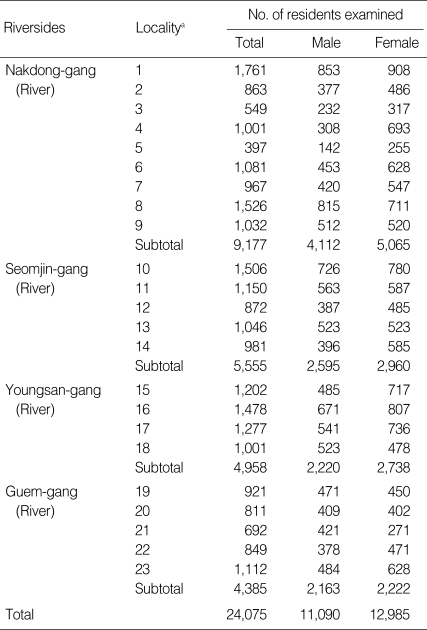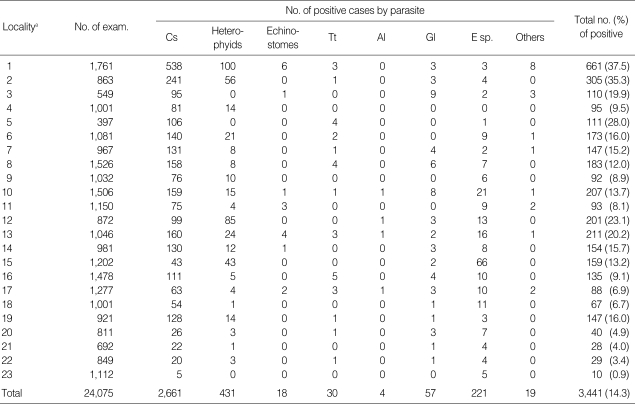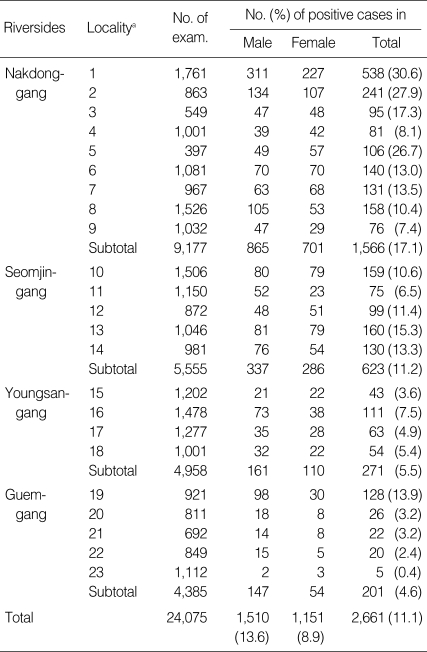Abstract
This study was performed to investigate prevalence of clonorchiasis among the inhabitants living in villages along the 4 major rivers, Nakdong-gang (= river), Seomjin-gang, Youngsan-gang, and Guem-gang in southern Korea. From January to December 2006, a total of 24,075 stool samples (1 sample per an inhabitant) were collected in 23 localities and examined by the formalin-ether sedimentation technique. Of the inhabitants examined, 3,441 (14.3%) were found to harbor various types of intestinal parasite eggs, cysts or larvae. Numbers of infected people were 2,661 (11.1%) for Clonorchis sinensis, 431 (1.8%) for heterophyids, 226 (0.9%) for Entamoeba spp., 57 (0.2%) for Giardia lamblia, 30 (0.1%) for Trichuris trichiura, and 18 (0.07%) for echinostomes. Prevalence rates of clonorchiasis according to the river basin were 17.1% in Nakdong-gang, 11.2% in Seomjin-gang, 5.5% in Youngsan-gang and 4.6% in Guem-gang. Of the 2,661 C. sinensis egg-positive cases, 57.7% was male. The present findings suggest that clonorchiasis is still highly prevalent among inhabitants in the riverside areas of southern Korea, and it is necessary to implement a systematic control program in the endemic areas.
Keywords: Clonorchis sinensis, prevalence, fecal examination
INTRODUCTION
Human helminthiasis has been highly endemic in Korea for a long time. In the past, it was distributed along most major river basins over the country. A rapid decrease in the overall prevalence of intestinal parasites during the past decade is attributed by continuous efforts for nationwide control programs undertaken by the Korean government to reduce the prevalence of soil-transmitted nematode infections and to improve hygiene and sanitary conditions of Koreans. However, despite this remarkable control of soil-transmitted nematode infections, the prevalence of fish-borne trematode infections such as with C. sinensis and Metagonimus spp. has maintained at relatively high levels, particularly in riverside areas [1].
Clonorchiasis is endemic in East Asian countries with estimated infections of 35 million people [2]. National surveys revealed egg positive rates of C. sinensis in general population as 4.6% in 1971, 1.8% in 1976, 2.6% in 1981, 2.7% in 1986, 2.2% in 1992, 1.4% in 1997, and 2.9% in 2004 [3]. The infection of C. sinensis is contracted by eating undercooked fishes which harbor the metacercariae. Contaminated fishes are mainly found from streams and rivers where the freshwater snails, Parafossarulus manchouricus thrive. Especially, many endemic foci of C. sinensis were located along the 7 major rivers of South Korea. In 1981, the egg positive rates of people living in those river basins differed considerably; 40.2% in Nakdong-gang (= river), 30.8% in Yeongsan-gang, 17.3% in Seomjin-gang, 15.7% in Han-gang, 15.9% in Tamjin-gang, 12.0% in Geum-gang, and 8.0% in Mangyeong-gang [4]. The liver fluke in the biliary passage provokes severe pathological changes therein, such as bile duct dilatation, ductal wall thickening, ductal inflammation, biliary mucosal hyperplasia, and biliary cirrhosis [1]. C. sinensis was found to induce cholangiocarcinoma in experimental hamsters as a promoter [5]. Clonorchiasis has been recognized as one of risk factors of development of cholangiocarcinoma in humans [6-8].
The present survey on the prevalence and distribution of human clonorchiasis endemic in Korea is one of the prerequi-sites for the government to implement its national control measures. Although some local data are previously available on this issue, no nationwide surveys have been conducted to determine the breadth of the problem. In this study, we evaluated the prevalence and distribution of clonorchiasis in a large scale survey and compared the endemicity among the endemic areas scattered in the southern part of Korean Peninsula.
MATERIALS AND METHODS
Surveyed area
Twenty-three counties were selected in 4 river basins which were located near or alongside the major rivers of Korea, for this study with reference to the nationwide survey in 2004 [3] (Fig. 1). A total of 24,075 inhabitants (male 11,090 and female 12,985) were screened of their intestinal parasites in the selected localities (Table 1). This study was undertaken for 1 yr from January to December, 2006.
Fig. 1.
The surveyed areas (•) and 4 major rivers located in southern parts of Korea.
Table 1.
The subject of investigation by the riverside, locality and sex
aLocality designated in Fig. 1.
Stool collection and examination
Stool specimens were collected in plastic containers and transferred to the laboratory of National Institute of Health (NIH). The subjects for stool sampling were recruited from villages by a random household sampling method to assess the prevalence of parasitic infection. The formalin-ether sedimentation technique was used to examine helminth eggs, larvae, and protozoan cysts. One gram of each fecal sample was fixed with 10% neutral formalin in a 10 ml test tube. The formalin-fixed stool specimen was further processed by the formalin-ether concentration technique and examined for parasites in the laboratory. Parasite positive individuals were treated with praziquantel and other appropriate anti-parasitic drugs at the end of the study.
Statistical analysis
Comparisons of the prevalence parameters were assessed by the Student's t-test. Due to the distribution of the data for statistical significance by variation of intensity of infection was analyzed using the non-parametric analysis of variance. P < 0.05 was considered significant.
RESULTS
Positive rate of intestinal parasites
Of 24,075 examined stool samples, 3,441 (14.3%) were found to contain various intestinal parasite eggs, cysts or larvae. The helminth eggs detected were C. sinensis 2,661 (11.05%), heterophyids 431 (1.79%), echinostomes 18 (0.075%), Trichuris trichiura 30 (0.125%), Hookworms 5 (0.021%), Ascaris lumbricoides 4 (0.017%), Trichostrongylus orientalis 3 (0.012%), Taenia sp. 3 (0.012%), and Diphyllobothrium latum 1. Protozoan cysts were observed, Giardia lamblia from 57 (0.237%) and Entamoeba spp. from 221 (0.918%) individuals (Table 2).
Table 2.
Results of stool examination according to administrative regions
Cs, Clonorchis sinensis; Tt, Trichuris trichiura; Al, Ascaris lumbricoides; Gl, Giardia lamblia; E sp, Entamoeba.
aLocality designated in Fig. 1.
Prevalence of C. sinensis by river basin
The positive rates of C. sinensis eggs by rivers, localities and sexes were summarized in Table 3. The overall egg positive rate of C. sinensis was 11.1%. The highest rate was observed in river basin of Nakdong-gang 17.1%, from 7.4% to 30.6% by counties: 30.6% in Sancheong-gun, 27.9% in Jinju-si, 26.7% in Changwon-si, 17.3% in Sangju-si, 13.5% in Miryang-si, 13.0% in Haman-gun, and 7.4% in Changnyong-gun (Table 3). In river basin of Seomjin-gang, the egg positive rate varied from 6.5% to 15.3%. In river basin of Youngsan-gang, the egg positive rate varied from 3.6% to 7.5%, and the rate varied from 0.4% to 13.9% in the river basin of Guem-gang. The overall egg positive rate of male inhabitants was 13.6% ranging from 0.4% to 36.5% by river basin, and that of females was 8.9% in average with a range from 0.5% to 25.0% (P < 0.05).
Table 3.
Positive rates of Clonorchis sinensis eggs according to riversides, localities, and sexes
aLocality designated in Fig. 1.
Positive rate of C. sinensis eggs by age group
To evaluate the prevalence of C. sinensis by age group, a total of 23,979 cases of the 24,075 whole examined individuals were subjected to analysis. The positive rate of C. sinensis was highest in 50-59 yr group (12.8%), followed by the order of 60-69 (12.6%), 40-49 (11.5%) and 70-79 (9.9%), whereas it decreased in those aged below 40 yr (Table 4).
Table 4.
Number of egg positive cases of Clonorchis sinensis according to riversides and age groups
aNot exactly known.
DISCUSSION
The present study recognized that the overall prevalence of intestinal parasites was 14.3%, and 3,117 individuals were infected with trematodes, 42 with nematodes, 4 with cestodes and 283 with protozoa. This result is considerably higher than that of a previous nationwide survey previously performed in 2004 [3]. KCDC and KAHP (2004) surveyed intestinal helminth infections nationwidely, and observed a 4.3% egg positive rate [3]. The nationwide survey in 2004 included subjects according to a statistical stratified sampling method upon population census, however, the present study subjected all available residents in villages where clonorchiasis is endemic or suspected. That is the main reason of the higher egg positive rate (11.1%) of C. sinensis of the present study than that (2.9%) of the nationwide survey in 2004. In this context, it is more reasonable to compare the present results with those of Seo et al. (1981). That is because Seo et al. (1981) recovered helminth eggs from residents along the major rivers in Korea.
In 1981, the egg positive rate of C. sinensis was 15.7% at theriver basin of Han-gang, 12.0% at the Geum-gang river basin,8.0% at the Mangyeong-gang river basin, 30.8% at the Yeongsan-gang river basin, 17.3% at the Seomjin-gang river basin, and 40.2% at the Nakdong-gang river basin [4]. The egg positive rate of the present study was 4.6% at the Geum-gang river basin, 5.5% at the Yeongsan-gang river basin, 11.2% at the Seomjin-gang river basin, and 17.1% at the Nakdong-gang river basin. The egg positive rates at the individual river basins decreased remarkably compared with those at the same river basins in 1981 [4]. However, clonorchiasis is regarded as a persisting helminthiasis in Korea because almost all of other past prevalent helminthiases have disappeared throughout the country [1]. Especially the river basins of Nakdong-gang and Seomjin-gang are still endemic.
The average egg positive rate of C. sinensis among males was 13.6% which ranged from 0.4% to 36.5% by riverside areas, and that among females was 8.9% with a range from 0.5% to 25.0%. The age-specific egg positive rate increased as age increased, reaching a maximum of 12.8% in the 50-59 yr group. The egg positive rate of C. sinensis in men was more remarkable that of whole population, highest in 50-59 yr (12.8%), fol-lowed in order by 60-69 (12.6%), 40-49 (11.5%), and 70-79 (9.9%). The prevalence of C. sinensis by age showed one peak at the age of 40-49 or 50-59 yr in the past [9]. In every endemic area under natural equilibrium of clonorchiasis, the egg positive rate and the infection intensity increase linearly by age up to the 50s or 60s and make a peak, and then rapidly decrease afterwards. Since the life span of C. sinensis is known 30 yr or more, the peak is explained as an accumulation effect of life-long re- or super-infection with age. Human body develops no protective impact to re- or super-infection. However, the egg positive rate decreases after the peak in spite of the cumulative effect in the aged groups of 60s or more. This decreasing phenomenon in senior groups may suggest the possibility of shorter life span of residents with clonorchiasis than that of uninfected ones at the endemic areas [10]. Our data updated recent status of clonorchiasis in endemic areas of Korea as reduced egg positive rate and lower intensity of infection compared with those of previous reports [4,9,11,12]. Whole and age-specific egg positive rates have decreased, and the age-specific peak moves to 60s from 40s or 50s. This movement is an outcome of low endemicity by praziquantel medication. In other words, clonorchiasis in the endemic area in Korea is under continuous anthelminthic intervention, and the intervention makes the peak movement. The intervention has reduced also frequencies of complications of clonorchiasis as well as egg positive rate and intensity of infection [13].
Our findings reveal several other helminth eggs than C. sinensis, such as heterophyids, Gymnophalloides seoi, Echinostoma spp., Fasciola hepatica, A. lumbricoides, T. trichiura, hookworms, T. orientalisand D. latum. These various helminths have been prevalent in whole Korea in the past but most of them are now rapidly disappearing. In most of the southern parts of Korea, however, especially the fish-mediated helminths are still remaining as well as C. sinensis [14]. The localities of the helminthic infections are agricultural areas and the environment is well-preserved with minimum pollution.
In conclusion, we confirmed the presence of light to moderate endemicity of clonorchiasis and also observed other intestinal helminths in southern localities of Korea in 2006. Continuous and repeated praziquantel medication is necessary in the endemic areas in Korea.
ACKNOWLEDGEMENTS
This study was supported by an Endemic Diseases Control Program of the National Institute of Health, Ministry of Health and Welfare, Republic of Korea (NIH-4800-4847-302).
References
- 1.Hong ST, Chai JY, Choi MH, Huh S, Rim HJ, Lee SH. A successful experience of soil-transmitted helminth control in the Republic of Korea. Korean J Parasitol. 2006;44:177–185. doi: 10.3347/kjp.2006.44.3.177. [DOI] [PMC free article] [PubMed] [Google Scholar]
- 2.Lun ZR, Gasser RB, Lai DH, Li AX, Zhu XQ, Yu XB, Fang YY. Clonorchiasis: a key food-borne zoonosis in China. Lancet Infect Dis. 2005;5:31–41. doi: 10.1016/S1473-3099(04)01252-6. [DOI] [PubMed] [Google Scholar]
- 3.Korea Centers for Disease Control and Prevention. Korea Association of Health Promotion: prevalence of intestinal parasites in Korea. The 7th Report. Seoul, Korea: Art Motion; 2004. [Google Scholar]
- 4.Seo BS, Lee SH, Cho SY, Chai JY, Hong ST, Han IS, Sohn JS, Cho BH, Ahn SR, Lee SK, Chung SC, Kang KS, Shim HS, Hwang IS. An epidemiologic study on clonorchiasis and metagonimiasis in riverside areas in Korea. Korean J Parasitol. 1981;19:137–150. doi: 10.3347/kjp.1981.19.2.137. [DOI] [PubMed] [Google Scholar]
- 5.Lee JH, Yang HM, Bak UB, Rim HJ. Promoting role of Clonorchis sinensis infection of induction of cholangiocarcinoma during two-step carcinogenesis. Korean J Parasitol. 1994;32:13–18. doi: 10.3347/kjp.1994.32.1.13. [DOI] [PubMed] [Google Scholar]
- 6.Shim HS, Lim BJ, Kim MJ, Lee WJ, Park CI, Park YN. Mucinous cholangiocarcinoma associated with Clonorchis sinensis infestation: a case report. Korean J Hepatol. 2004;10:223–227. [PubMed] [Google Scholar]
- 7.Lim MK, Ju YH, Franceschi S, Oh JK, Kong HJ, Hwang SS, Park SK, Cho SI, Sohn WM, Kim DI, Yoo KY, Hong ST, Shin HR. Clonorchis sinensis infection and increasing risk of cholangiocarcinoma in the Republic of Korea. Am J Trop Med Hyg. 2006;75:93–96. [PubMed] [Google Scholar]
- 8.Choi D, Lim JH, Lee KT, Lee JK, Choi SH, Heo JS, Jang KT, Lee NY, Kim S, Hong ST. Cholangiocarcinoma and Clonorchis sinensis infection: a case-control study in Korea. J Hepatol. 2006;44:1066–1073. doi: 10.1016/j.jhep.2005.11.040. [DOI] [PubMed] [Google Scholar]
- 9.Rim HJ. Clonorchiasis: an update. J Helminthol. 2005;79:269–281. doi: 10.1079/joh2005300. [DOI] [PubMed] [Google Scholar]
- 10.Hong ST. Clonorchis sinensis. In: Miliotis MD, Bier JW, editors. International Handbook of Food-borne Pathogens. New York: Marcel Dekker Inc; 2003. pp. 581–592. [Google Scholar]
- 11.Kim BJ, Ock MS, Kim IS, Yeo UB. Infection status of Clonorchis sinensis in residents of Hamyang-gun, Gyeongsangnam-do, Korea. Korean J Parasitol. 2002;40:191–193. doi: 10.3347/kjp.2002.40.4.191. [DOI] [PMC free article] [PubMed] [Google Scholar]
- 12.Lee GS, Cho IS, Lee YH, Noh HJ, Shin DW, Lee SG, Lee TY. Epidemiological study of clonorchiasis and metagonimiasis along the Geum-gang (river) in Okcheon-gun (county), Korea. Korean J Parasitol. 2002;40:9–16. doi: 10.3347/kjp.2002.40.1.9. [DOI] [PMC free article] [PubMed] [Google Scholar]
- 13.Hong ST, Rim HJ, Min DY, Li X, Xu J, Feng Z, Lee SH. Control of clonorchiasis by repeated treatments with praziquantel. Korean J Parasitol. 2001;39:285–292. doi: 10.3347/kjp.2001.39.4.285. [DOI] [PMC free article] [PubMed] [Google Scholar]
- 14.Chai JY, Murrell KD, Lymbery AJ. Fish-borne parasitic zoonoses: status and issues. Int J Parasitol. 2005;35:1233–1254. doi: 10.1016/j.ijpara.2005.07.013. [DOI] [PubMed] [Google Scholar]







